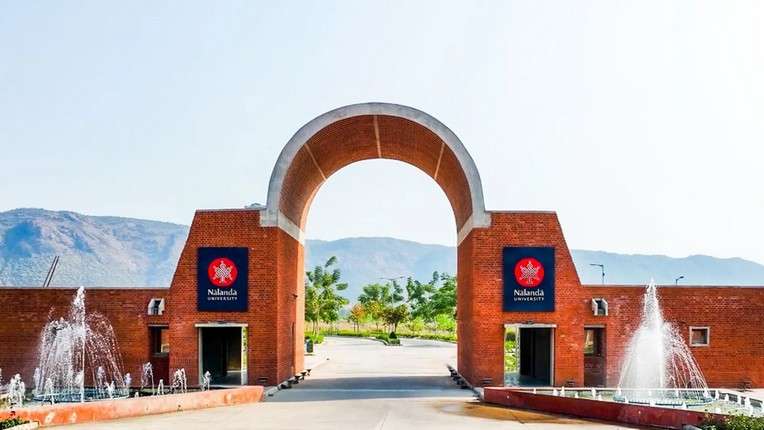
“Nalanda is a great symbol of our ancient heritage. It was a seat of knowledge that attracted scholars from all over the world.” – Narendra Modi.
On 19th June 2025, Prime Minister Narendra Modi inaugurated a new chapter in the university’s history, unveiling the new campus in Rajgir, Bihar. This momentous event, attended by dignitaries from 17 nations, marked a collaborative effort between India and East Asia Summit (EAS) countries.
But before we step into this exciting future, let us turn our gaze to Nalanda’s architectural marvels, remnants of a glorious past that continue to inspire us today!
A Legacy Etched in Time: Exploring Nalanda’s Historical Journey
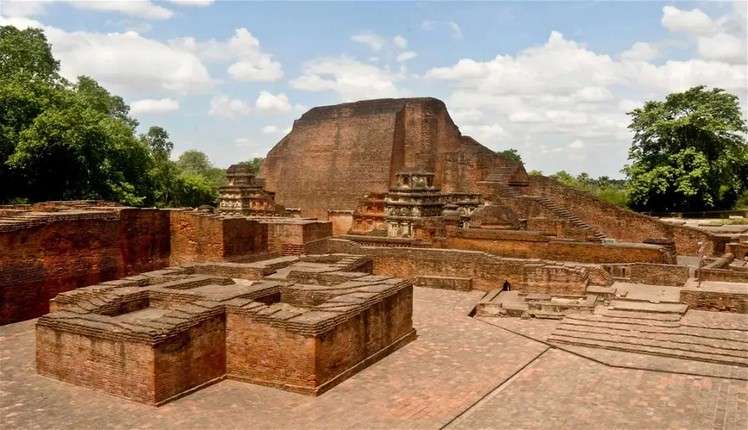
Nalanda University traced its origins to the fifth century CE and operated as a prestigious learning centre for 800 uninterrupted years. Developed by Kumaragupta 1, it thrived under the patronage of Gupta dynasty emperors during the fifth and sixth centuries and continued to flourish under Emperor Harshavardhan of Kannauj in the seventh century. The university maintained its prominence until the ninth century, after which it began to experience a gradual decline.
At its peak, Nalanda attracted students and scholars from far-flung regions, including Central Asia, Tibet, China, and Korea. It housed over 2,000 instructors and 10,000 students. Historical records indicate that Mahavira and Buddha visited Nalanda in the fifth and sixth centuries. In the seventh century, the renowned Chinese scholar Hsuan-Tsang visited the university to study the Vedas, Buddhist theology, and metaphysics.
After its decline, Nalanda faded into obscurity until the Archaeological Survey of India began excavations in the 19th century. These excavations have uncovered numerous ruins, representing only a small portion of the vast Nalanda institution.
The Architectural Splendour of Nalanda
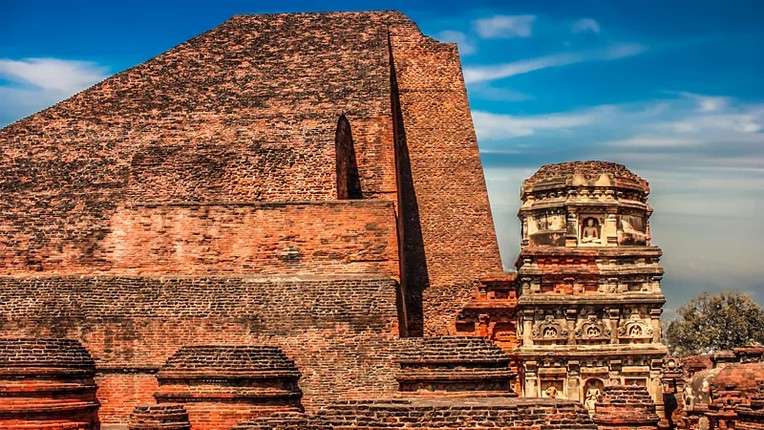
Nalanda University wasn’t just a centre of intellectual thought but a breathtaking piece of architecture purely made out of brick. The layout was thoughtfully designed, blending practical needs with visual appeal. The vast campus included numerous viharas (monasteries) and chaityas (temples), surrounded by lush gardens and expansive courtyards. The buildings were constructed using red bricks, a hallmark of the region’s architectural style, and featured elaborate carvings and inscriptions.
Nalanda University’s interiors are thought to have been decorated with elaborate artwork and inscriptions despite being mostly destroyed by time. Simple yet practical designs emphasised utility and simplicity over extravagance in the scholar’s living spaces.
The temples had intricated carvings and sculptures depicting Buddhist iconography. Nalanda’s architecture also incorporated advanced features such as a centralised water supply system and efficient drainage, highlighting the dexterity of its builders. The ruins of Nalanda’s detailed craftsmanship and thoughtful design offer a glimpse into a thriving academic and spiritual hub that attracted scholars worldwide. One of the biggest attractions of Nalanda University was its library.
Nalanda University from Ruins to the Present Day

Nalanda thrived during the Middle Ages within a vast complex, but only a fraction has been excavated. Today, the remnants of Nalanda Mahavihara stand as a testament to its past glory, making it one of Patna’s most significant historical sites due to its cultural, educational, and religious importance. Recognised as a UNESCO World Heritage Site and maintained by the Archaeological Survey of India, the ruins are crucial for anyone studying Buddhism. The site also features temples, a museum, and remains of other structures, offering a comprehensive glimpse into its rich history.
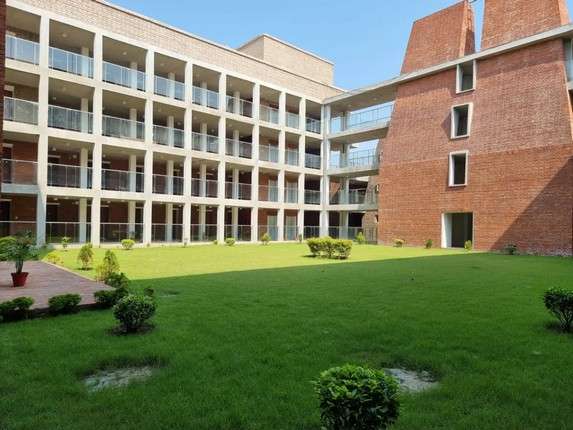
Prime Minister Modi’s inauguration of Nalanda University’s new campus today marks a significant milestone. The institution unveils impressive facilities like:-
- The campus includes two academic blocks housing 40 classrooms that can accommodate around 1,900 students alongside two auditoriums with 300 seats each. A student hostel is available for approximately 550 students. Moreover, the campus features an international centre, an amphitheatre with a capacity of up to 2,000 people, a faculty club, a sports complex, and various other amenities.
- Regarding the university’s architecture, the main wall consists of two parallel walls with a cavity in the middle designed to trap heat. Additionally, the university plans to utilise the heat from air conditioners to generate hot water for the bathrooms.
- The academic spine, which will house all schools and centres of study, features open rooms that resemble the student cells at Nalanda Mahavihara. These spaces are intended to be used as study areas by the students.
- At the heart of the campus will be the Kamal Sagar (lotus pond), adjacent to which will be a horizontal chain of arcades, or “bottle-shaped bazaars,” where students can purchase various items, from stationery to food.
The Significance of Nalanda’s New Developments
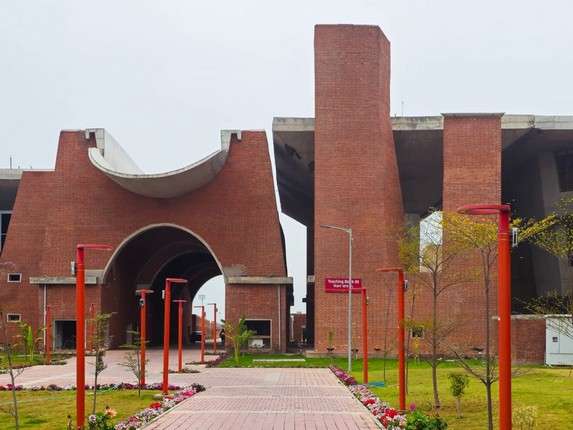
Crafted from locally obtained materials, the front of Nalanda University reflects the architectural delicacy of the era. The exteriors were decorated with intricately carved designs featuring religious symbolism and everyday life scenes. In addition to demonstrating sustainable architecture techniques, regional materials highlight a close relationship to the surrounding environment.
Crafted from locally obtained materials, the front of Nalanda University reflects the architectural delicacy of the era. The exteriors were decorated with intricately carved designs featuring religious symbolism and everyday life scenes. In addition to demonstrating sustainable architecture techniques, regional materials highlight a close relationship to the surrounding environment.
Less Known Facts About Nalanda University
- The university featured one of the world’s largest libraries, Dharmaganja, which housed millions of manuscripts. It was divided into three buildings: Ratnasagara, Ratnodadhi, and Ratnaranjaka.
- The curriculum at Nalanda was diverse, covering subjects such as theology, grammar, logic, astronomy, metaphysics, medicine, mathematics, and Buddhist studies.
- The university’s architecture was remarkably advanced for that era, encompassing diverse elements – temples, halls for meditation, classrooms, lakes, gardens, and monasteries. The campus layout was crafted to cultivate an environment conducive to deep reflection and learning.
Conclusion
Nalanda’s architectural splendour is undeniably inspiring, a testament to the grandeur of ancient India. Yet, the true magic of Nalanda lies not just in the brick and mortar but in the spirit it embodied. Here, amidst these very ruins, the whispers of scholars from a bygone era still resonate. Giants of philosophy, logic, and medicine once roamed these halls, their thirst for knowledge a boundless flame that illuminated the world.
The new campus in Rajgir isn’t merely a reconstruction of the past; it is a melody echoing the ancient song of Nalanda. With its focus on diverse disciplines, collaborative learning, and a commitment to sustainability, the new Nalanda aspires to emulate and surpass its glorious past.
As Prime Minister Modi rightly stated, Nalanda is a “great symbol of our ancient heritage,” a beacon that continues to guide us on intellectual exploration.
